Does Increasing Natural Gas Demand in the Power Sector Pose a Threat of Congestion to the German Gas Grid? A Model-Coupling Approach
Abstract
1. Introduction
2. Methodology
2.1. General Approach and Interface between the Electricity and Gas Models
2.2. The Electricity Model—Joint Market Model (JMM)
2.3. The Gas Model—Gas Market Model for Germany (GAMAMOD-DE)
2.4. Benefits and Drawbacks of the Selected Approach
2.5. Research Design and Data Assumptions
3. Results and discussion
3.1. Backtesting 2012: Coupling JMM and GAMAMOD
3.2. Increased Installed Capacity of Gas Power Plants Drives Gas Demand in 2030
3.3. German Gas Network with Limited Increased Load Shedding Exhibits Resiliency in 2030
3.4. Implications of Gas Grid Congestion for the Electricity System
4. Limitations of this Study
5. Conclusions
Author Contributions
Funding
Acknowledgments
Conflicts of Interest
Appendix A
Appendix A.1. Cross-Border Natural Gas Prices in 2012 and 2030
| Month | Price 2012 [in EUR/GWhth] | Price 2030 [in EUR/GWhth] |
|---|---|---|
| January | 22,400.00 | 24,067.97 |
| February | 22,400.00 | 24,067.97 |
| March | 22,400.00 | 24,067.97 |
| April | 25,350.00 | 27,247.82 |
| May | 25,350.00 | 27,247.82 |
| June | 25,350.00 | 27,247.82 |
| July | 24,050.00 | 25,850.50 |
| August | 24,050.00 | 25,850.50 |
| September | 24,050.00 | 25,850.50 |
| October | 26,430.00 | 28,408.68 |
| November | 26,430.00 | 28,408.68 |
| December | 26,430.00 | 28,408.68 |
Appendix A.2. Comparison of Simulated and Historical Gas Imports in 2012
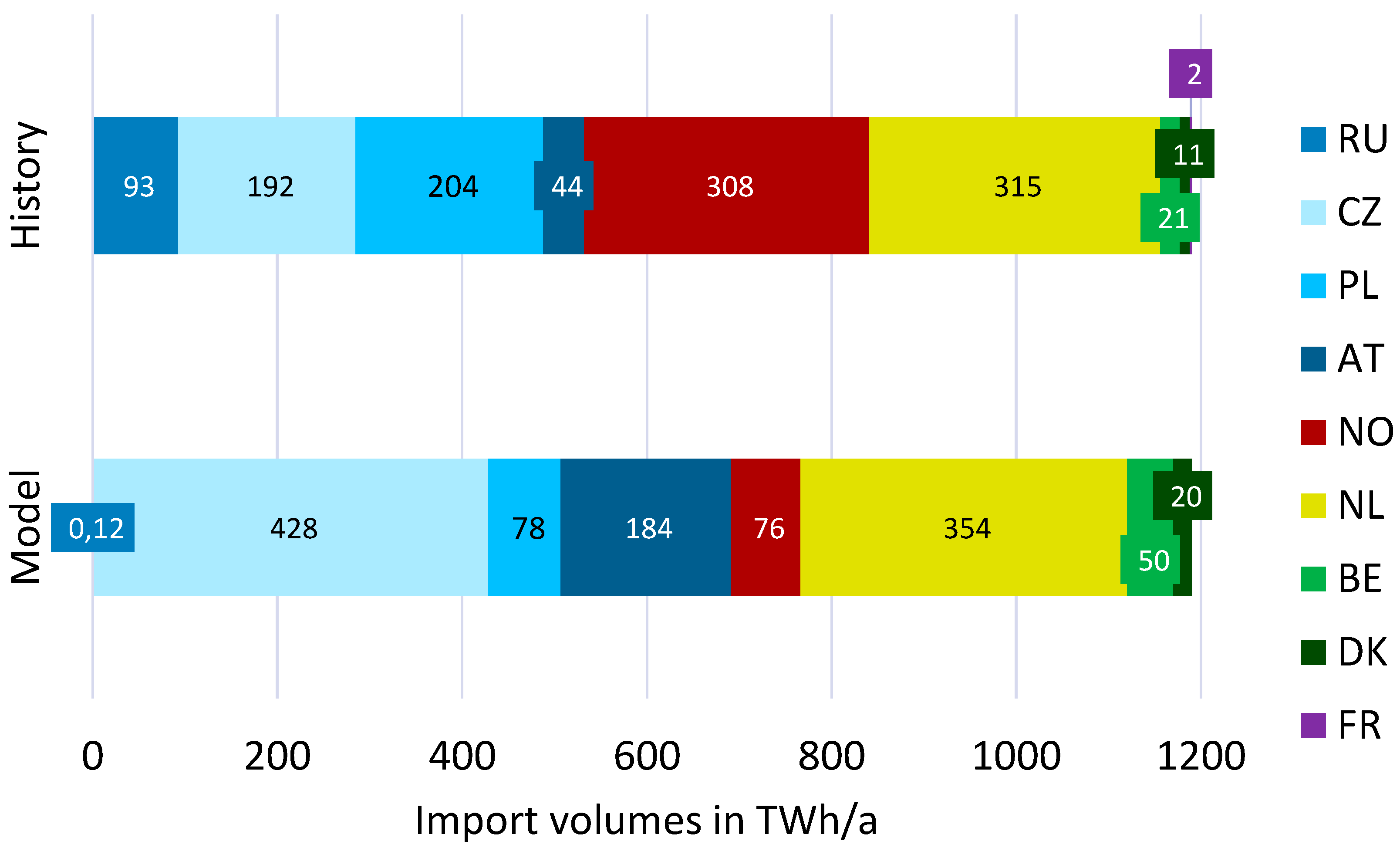
References
- Eurostat. Energy Balances—Eurostat. Available online: https://ec.europa.eu/eurostat/web/energy/data/energy-balances (accessed on 4 February 2019).
- Jessen-Thiesen, P.; Schönheit, D.; Hladik, D.; Dierstein, C.; Zöphel, C.; Möst, D. Dauer und Häufigkeit von Dunkelflauten in Deutschland. Energ. Tagesfr. 2019, 69, 62–65. [Google Scholar]
- Westphal, K. Security of gas supply: four political challenges under the spotlight. SWP Comments 2012, 17, 96. [Google Scholar]
- Henderson, J.; Heather, P. Lessons from the February 2012 European Gas “Crisis”; Oxford Institute for Energy Studies: Oxford, UK, 2012. [Google Scholar]
- DWD. Deutscher Wetterdienst. 2017. Available online: https://www.dwd.de/ (accessed on 3 June 2019).
- ENTSO-E. ENTSO-E Transparency Platform. 2017. Available online: https://transparency.entsoe.eu/ (accessed on 3 June 2019).
- IEA. Electricity Information 2015; International Energy Agency: Paris, France, 2016. [Google Scholar]
- Ang, B.W.; Choong, W.L.; Ng, T.S. Energy security: Definitions, dimensions and indexes. Renew. Sustain. Energy Rev. 2015, 42, 1077–1093. [Google Scholar] [CrossRef]
- Sovacool, B.K.; Mukherjee, I. Conceptualizing and measuring energy security: A synthesized approach. Energy 2011, 36, 5343–5355. [Google Scholar] [CrossRef]
- Kumar, S.; Hladik, D.; Hauser, P. Challenges in Measuring Security of Supply in Changing Electricity and Natural Gas Systems. 2018. Available online: https://www.google.com/url?sa=t&rct=j&q=&esrc=s&source=web&cd=1&cad=rja&uact=8&ved=2ahUKEwjhiN7fr83iAhXFDuwKHRwxBIUQFjAAegQIARAC&url=https%3A%2F%2Fwww.iaee.org%2Fen%2Fpublications%2Fnewsletterdl.aspx%3Fid%3D449&usg=AOvVaw0iRrwAqRYoPhCU0MbjG80D (accessed on 5 June 2019).
- Biresselioglu, M.E.; Yelkenci, T.; Oz, I.O. Investigating the natural gas supply security: A new perspective. Energy 2015, 80, 168–176. [Google Scholar] [CrossRef]
- Cabalu, H. Indicators of security of natural gas supply in Asia. Energy Policy 2010, 38, 218–225. [Google Scholar] [CrossRef]
- Dieckhöner, C. Simulating Security of Supply Effects of the Nabucco and South Stream Projects for the European Natural Gas Market. Energy J. 2012, 33, 153–181. [Google Scholar] [CrossRef]
- Hecking, H.; John, C.; Weiser, F. An Embargo of Russian Gas and Security of Supply in Europe. Z. Energiewirtsch. 2015, 39, 63–73. [Google Scholar] [CrossRef]
- Richter, P.M.; Holz, F. All quiet on the eastern front? Disruption scenarios of Russian natural gas supply to Europe. Energy Policy 2015, 80, 177–189. [Google Scholar] [CrossRef]
- Barcikowska, M.J.; Weaver, S.J.; Feser, F.; Russo, S.; Schenk, F.; Stone, D.A.; Wehner, M.F.; Zahn, M. Euro-Atlantic winter storminess and precipitation extremes under 1.5 °C vs. 2 °C warming scenarios. Earth Syst. Dyn. 2018, 9, 679–699. [Google Scholar] [CrossRef]
- Deane, J.P.; Ciaráin, M.Ó.; Gallachóir, B.P.Ó. An integrated gas and electricity model of the EU energy system to examine supply interruptions. Appl. Energy 2017, 193, 479–490. [Google Scholar] [CrossRef]
- Vandewalle, J.; Bruninx, K.; D’haeseleer, W. A Mixed-Integer Linear Operational Model of a Coupled Electricity, Natural Gas and Carbon Energy System with Power to Gas. 2014. Available online: https://www.mech.kuleuven.be/en/tme/research/energy_environment/Pdf/wpen 2014-16.pdf (accessed on 19 March 2019).
- Möst, D.; Perlwitz, H. Prospects of gas supply until 2020 in Europe and its relevance for the power sector in the context of emission trading. Energy 2009, 34, 1510–1522. [Google Scholar] [CrossRef]
- Antenucci, A.; Sansavini, G. Gas-Constrained Secure Reserve Allocation with Large Renewable Penetration. IEEE Trans. Sustain. Energy 2018, 9, 685–694. [Google Scholar] [CrossRef]
- Erdener, B.C.; Pambour, K.A.; Lavin, R.B.; Dengiz, B. An integrated simulation model for analysing electricity and gas systems. Int. J. Electr. Power Energy Syst. 2014, 61, 410–420. [Google Scholar] [CrossRef]
- Unsihuay, C.; Lima, J.W.M.; de Souza, A.C.Z. Modeling the Integrated Natural Gas and Electricity Optimal Power Flow. In Proceedings of the 2007 IEEE Power Engineering Society General Meeting, Tampa, FL, USA, 24–28 June 2007; pp. 1–7. [Google Scholar]
- Ameli, H.; Qadrdan, M.; Strbac, G. Value of gas network infrastructure flexibility in supporting cost effective operation of power systems. Appl. Energy 2017, 202, 571–580. [Google Scholar] [CrossRef]
- Pambour, K.A.; Cakir Erdener, B.; Bolado-Lavin, R.; Dijkema, G.P. SAInt—A novel quasi-dynamic model for assessing security of supply in coupled gas and electricity transmission networks. Appl. Energy 2017, 203, 829–857. [Google Scholar] [CrossRef]
- Dokic, S.B.; Rajakovic, N.L. Security modelling of integrated gas and electrical power systems by analyzing critical situations and potentials for performance optimization. Energy 2018, in press. [Google Scholar] [CrossRef]
- Wang, C.; Wei, W.; Wang, J.; Liu, F.; Mei, S. Strategic Offering and Equilibrium in Coupled Gas and Electricity Markets. IEEE Trans. Power Syst. 2018, 33, 290–306. [Google Scholar] [CrossRef]
- He, C.; Liu, T.; Wu, L.; Shahidehpour, M. Robust coordination of interdependent electricity and natural gas systems in day-ahead scheduling for facilitating volatile renewable generations via power-to-gas technology. J. Mod. Power Syst. Clean Energy 2017, 5, 375–388. [Google Scholar] [CrossRef]
- Shahidehpour, M.; Fu, Y.; Wiedman, T. Impact of Natural Gas Infrastructure on Electric Power Systems. Proc. IEEE 2005, 93, 1042–1056. [Google Scholar] [CrossRef]
- Kern, T.; Buchwitz, K.; Guminski, A.; von Roon, S. The Impact of Electrification on the Gas Sector. In Proceedings of the 15th International Conference on the European Energy Market (EEM), Lodz, Poland, 27–29 June 2018; pp. 1–5. [Google Scholar]
- Hauser, P.; Heinrichs, H.U.; Gillessen, B.; Müller, T. Implications of diversification strategies in the European natural gas market for the German energy system. Energy 2018, 151, 442–454. [Google Scholar] [CrossRef]
- Gillessen, B.; Heinrichs, H.; Hake, J.F.; Allelein, H.J. Energy security in context of transforming energy systems: A case study for natural gas transport in Germany. Energy Procedia 2019, 158, 3339–3345. [Google Scholar] [CrossRef]
- Kunz, F.; Kendziorski, M.; Schill, W.P.; Weibezahn, J.; Zepter, J.; von Hirschhausen, C.R.; Hauser, P.; Zech, M.; Möst, D.; Heidari, S.; et al. Electricity, Heat, and Gas Sector Data for Modeling the German System; Schriften des Lehrstuhls für Energiewirtschaft, TU Dresden: Dresden, Germany, 2018; Available online: http://nbn-resolving.de/urn:nbn:de:bsz:14-qucosa-233806 (accessed on 5 June 2019).
- Barth, R.; Brand, H.; Meibom, P.; Weber, C. A Stochastic Unit-commitment Model for the Evaluation of the Impacts of Integration of Large Amounts of Intermittent Wind Power. In Proceedings of the International Conference on Probabilistic Methods Applied to Power Systems (PMAPS 2006), Stockholm, Sweden, 11–15 June 2006; pp. 1–8. [Google Scholar]
- Tuohy, A.; Meibom, P.; Denny, E.; O’Malley, M. Unit Commitment for Systems with Significant Wind Penetration; University Library of Munich: München, Germany, 2009. [Google Scholar]
- Weber, C.; Meibom, P.; Barth, R.; Brand, H. WILMAR: A Stochastic Programming Tool to Analyze the Large-Scale Integration of Wind Energy. In Optimization in the Energy Industry; Kallrath, J., Pardalos, P.M., Rebennack, S., Scheidt, M., Eds.; Springer: Berlin/Heidelberg, Germany, 2009; pp. 437–458. [Google Scholar]
- Jahns, C.; Podewski, C.; Weber, C. Supply Curves for Hydro Reservoirs-Estimation and Usage in Large-Scale Electricity Market Models. HEMF Working Paper No. 01/2019. 31 January 2019. Available online: https://ideas.repec.org/p/dui/wpaper/1901.html (accessed on 5 June 2019).
- Meibom, P.; Barth, R.; Hasche, B.; Brand, H.; Weber, C.; O’Malley, M. Stochastic Optimization Model to Study the Operational Impacts of High Wind Penetrations in Ireland. IEEE Trans. Power Syst. 2011, 26, 1367–1379. [Google Scholar] [CrossRef]
- Trepper, K.; Bucksteeg, M.; Weber, C. An Integrated Approach to Model Redispatch and to Assess Potential Benefits from Market Splitting in Germany. EWL Working Paper 19/2013. 2013. Available online: https://dx.doi.org/10.2139/ssrn.2359328 (accessed on 5 June 2019).
- IEA. IEA—Gas Trade Flows in Europe. 2019. Available online: https://www.iea.org/gtf/ (accessed on 19 March 2019).
- Datastream International. 2019. Available online: https://www.thomsonreuters.com/en.html (accessed on 5 June 2019).
- Energiebilanzen, A. (Ed.) Energiebilanz der Bundesrepublik Deutschland. 2015. Available online: http://www.ag-energiebilanzen.de/index.php?article_id=29&fileName=bilanz15d.xlsx (accessed on 3 June 2019).
- Hauser, P. A Modelling Approach for the German Gas Grid Using Highly Resolved Spatial, Temporal and Sectoral Data (GAMAMOD-DE); ZBW—Leibniz Information Centre for Economics: Kiel/Hamburg, Germany, 2019. [Google Scholar]
- ENTSO-E. Ten-Year Network Development Plan 2018; ENTSO-E: Brussels, Belgium, 2018. [Google Scholar]
- Übertragungsnetzbetreiber. Szenariorahmen für die Netzentwicklungspläne Strom 2030 (Version 2019)—Entwurf der Übertragungsnetzbetreiber; Bundesnetzagentur: Bonn, Germany, 2018. [Google Scholar]
- LBEG. Jahresbericht “Erdöl und Erdgas in der Bundesrepublik Deutschland”. 2017. Available online: https://www.lbeg.niedersachsen.de/erdoel-erdgas-jahresbericht/jahresbericht-erdoel-und-erdgas-in-der-bundesrepublik-deutschland-936.html (accessed on 3 June 2019).
- Reuters. Dutch Government to Halt Gas Production at Groningen by 2030. 29 March 2018. Available online: https://www.reuters.com/article/netherlands-groningen-gas-idUSA5N1O601N (accessed on 24 April 2019).
- Hauser, P.; Schmidt, M.; Möst, D. Gas markets in flux: Analysis of components and influences for natural gas pricing in Europe. In Proceedings of the 13th International Conference on the European Energy Market. (EEM), Porto, Portugal, 6–9 June 2016; pp. 1–8. [Google Scholar]
- FNB. NEP 2016. 2016. Available online: https://www.fnb-gas.de/de/netzentwicklungsplan/nep-2016/nep-2016.html (accessed on 3 June 2019).
- Lochner, S. The Economics of Natural Gas Infrastructure Investments—Theory and Model-based Analysis for Europe. Ph.D. Thesis, Universität zu Köln, Köln, Germany, 2012. [Google Scholar]
- Bundesnetzagentur and Bundeskartellamt Monitoringbericht 2013. 2013. Available online: https://www.bundesnetzagentur.de/SharedDocs/Downloads/DE/Allgemeines/Bundesnetzagentur/Publikationen/Berichte/2015/Monitoringbericht_2015_BA.pdf?__blob=publicationFile&v=4 (accessed on 5 June 2019).
- Die Bundesregierung. Antwort der Bundesregierung—Engpässe in der Erdgasversorgung im Feb 2012. 13 June 2012. Available online: http://dip21.bundestag.de/dip21/btd/17/099/1709959.pdf (accessed on 6 November 2016).
- BNetzA. Projects of Common Interests (PCI) in Germany. 27 January 2016. Available online: https://www.bundesnetzagentur.de/EN/General/Bundesnetzagentur/InternationalActivities/ElectrictiyGas/PCI/PCI_karte.pdf?__blob=publicationFile&v=3 (accessed on 22 March 2019).
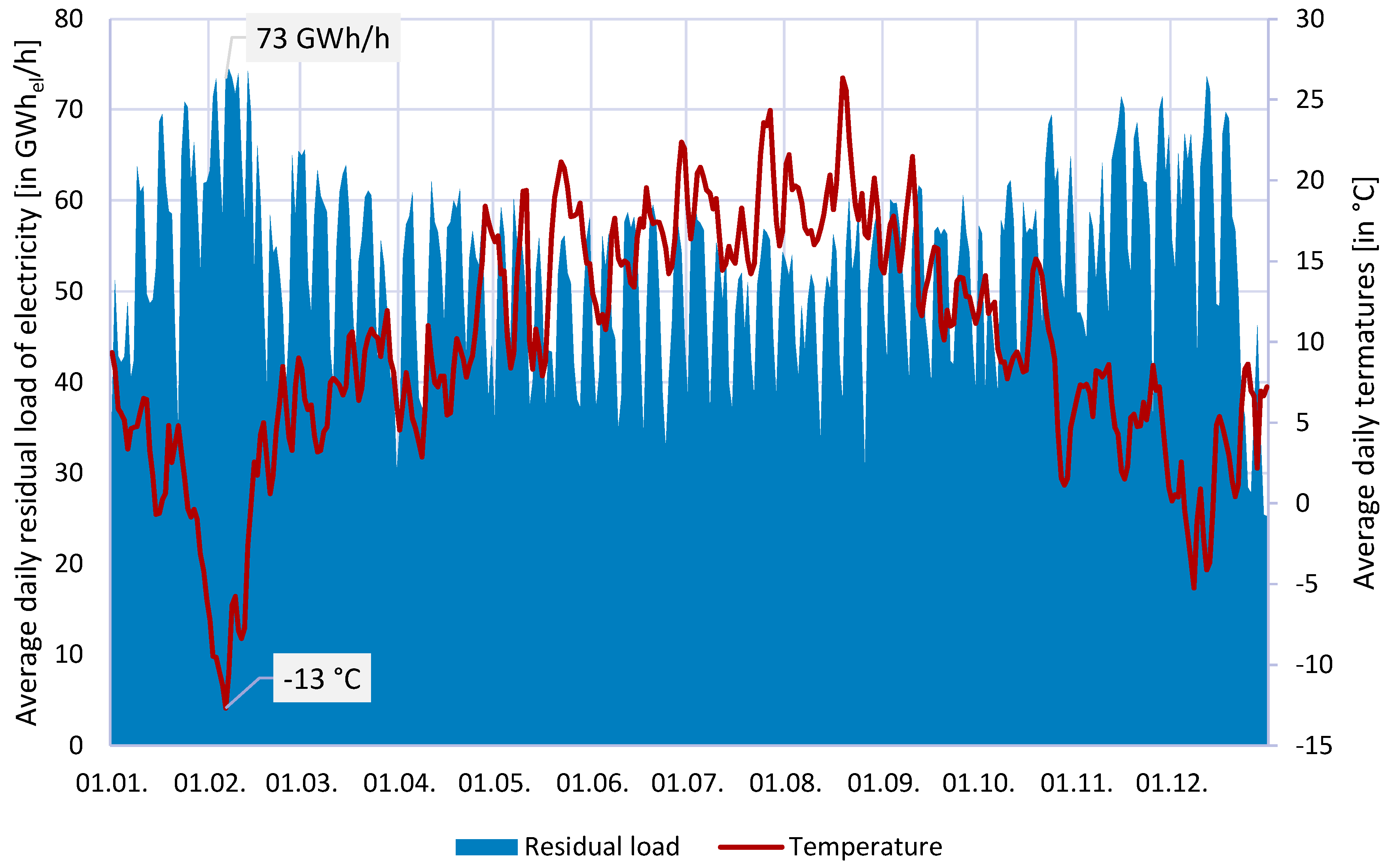
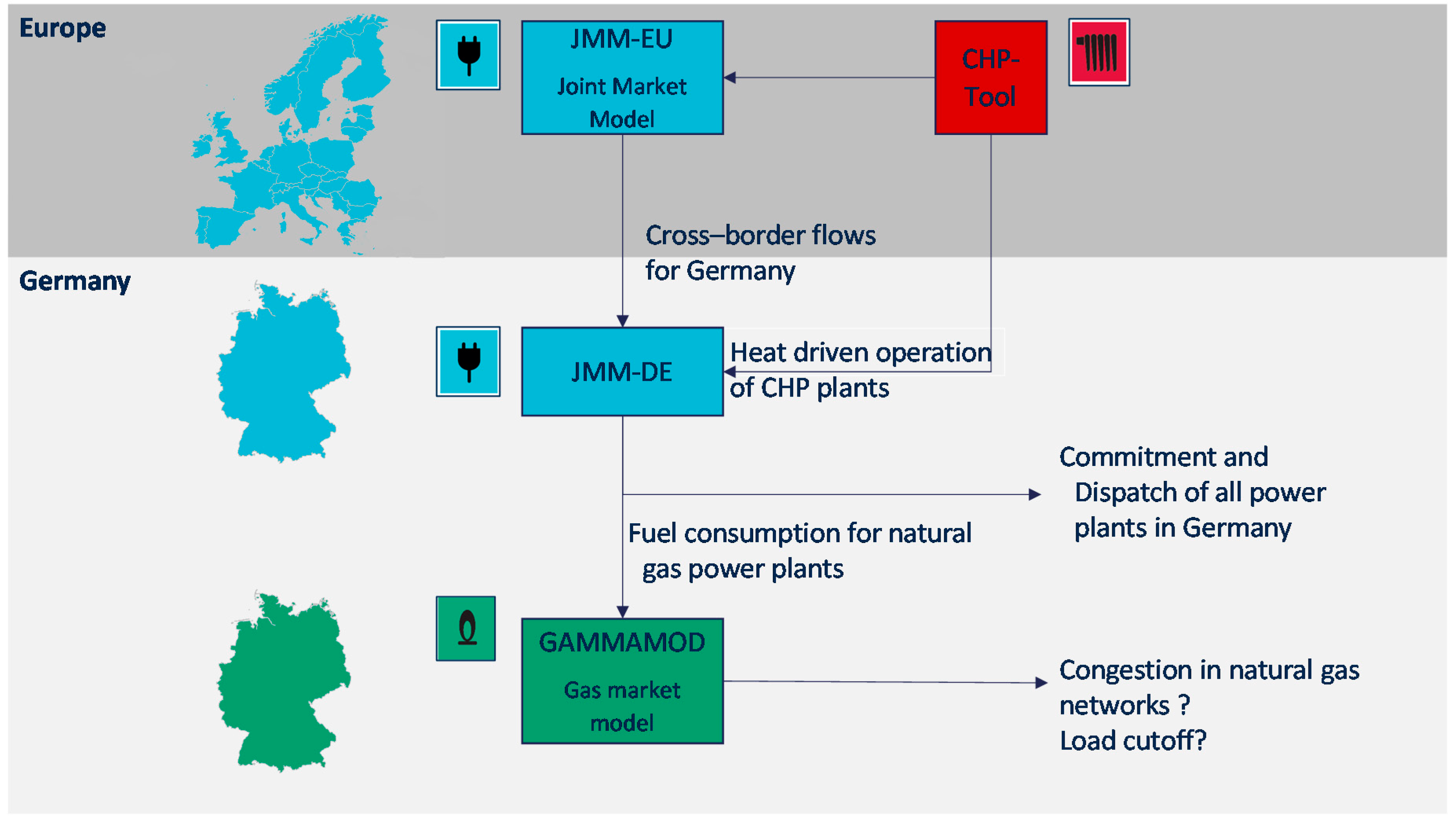
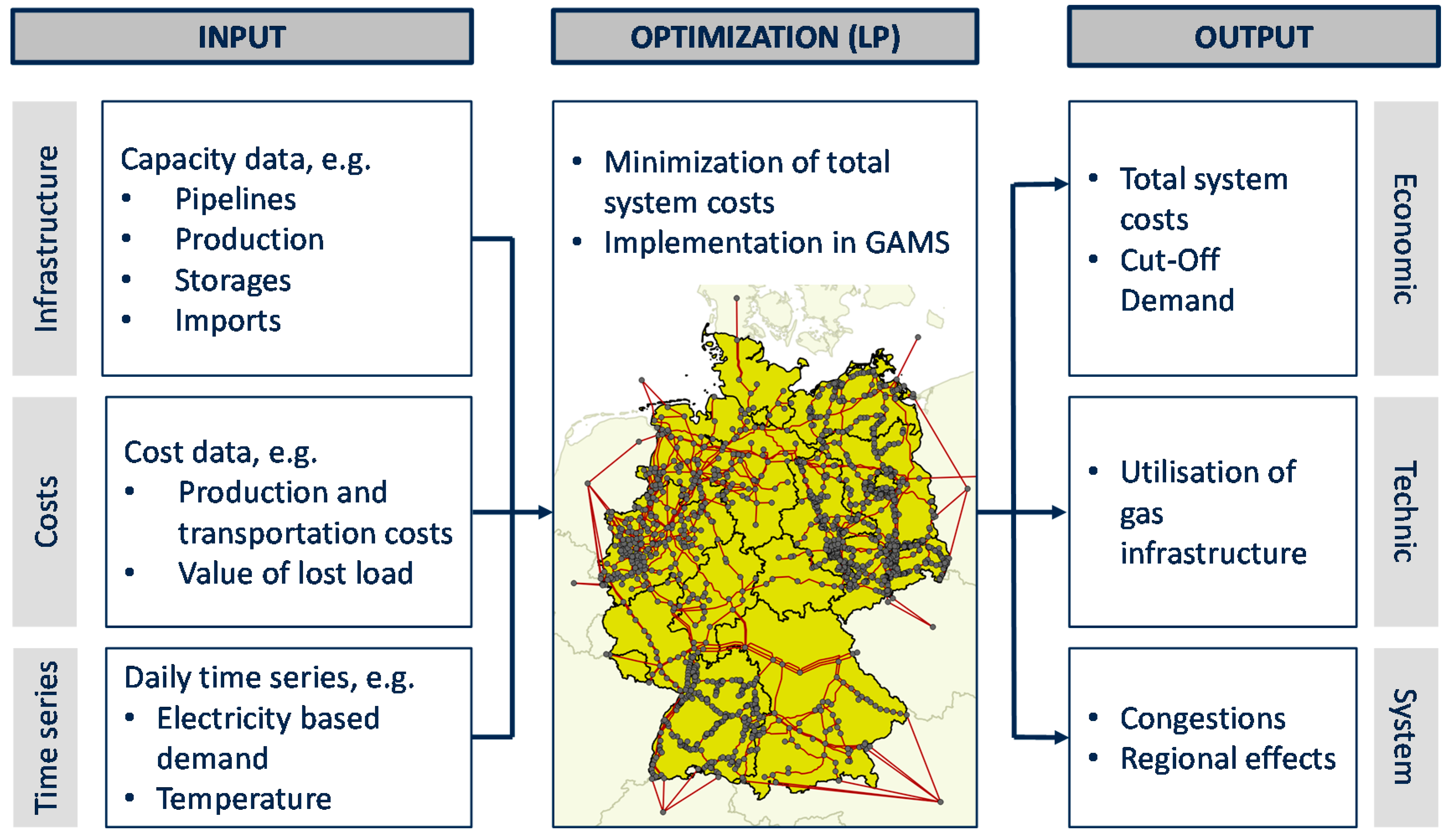
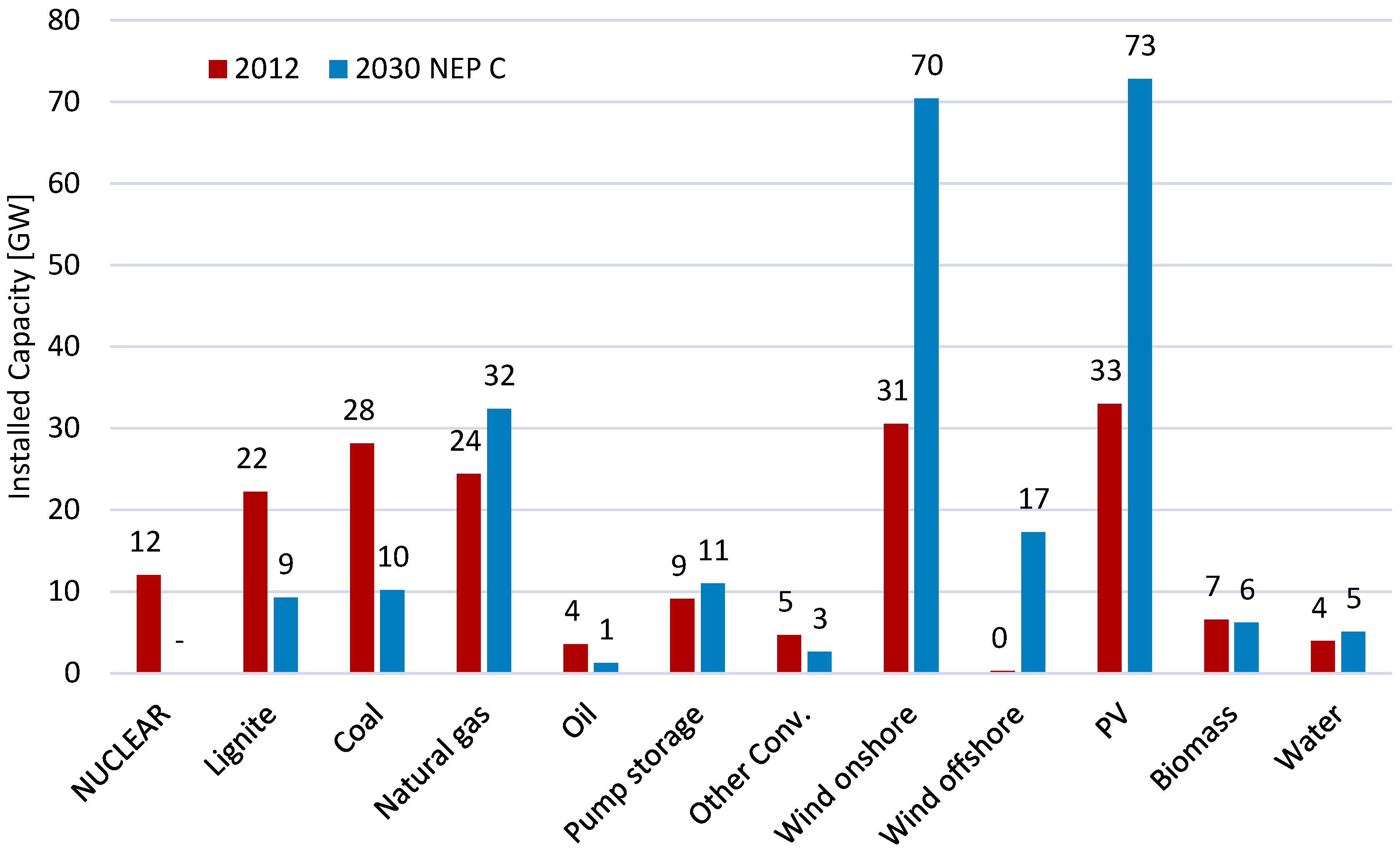
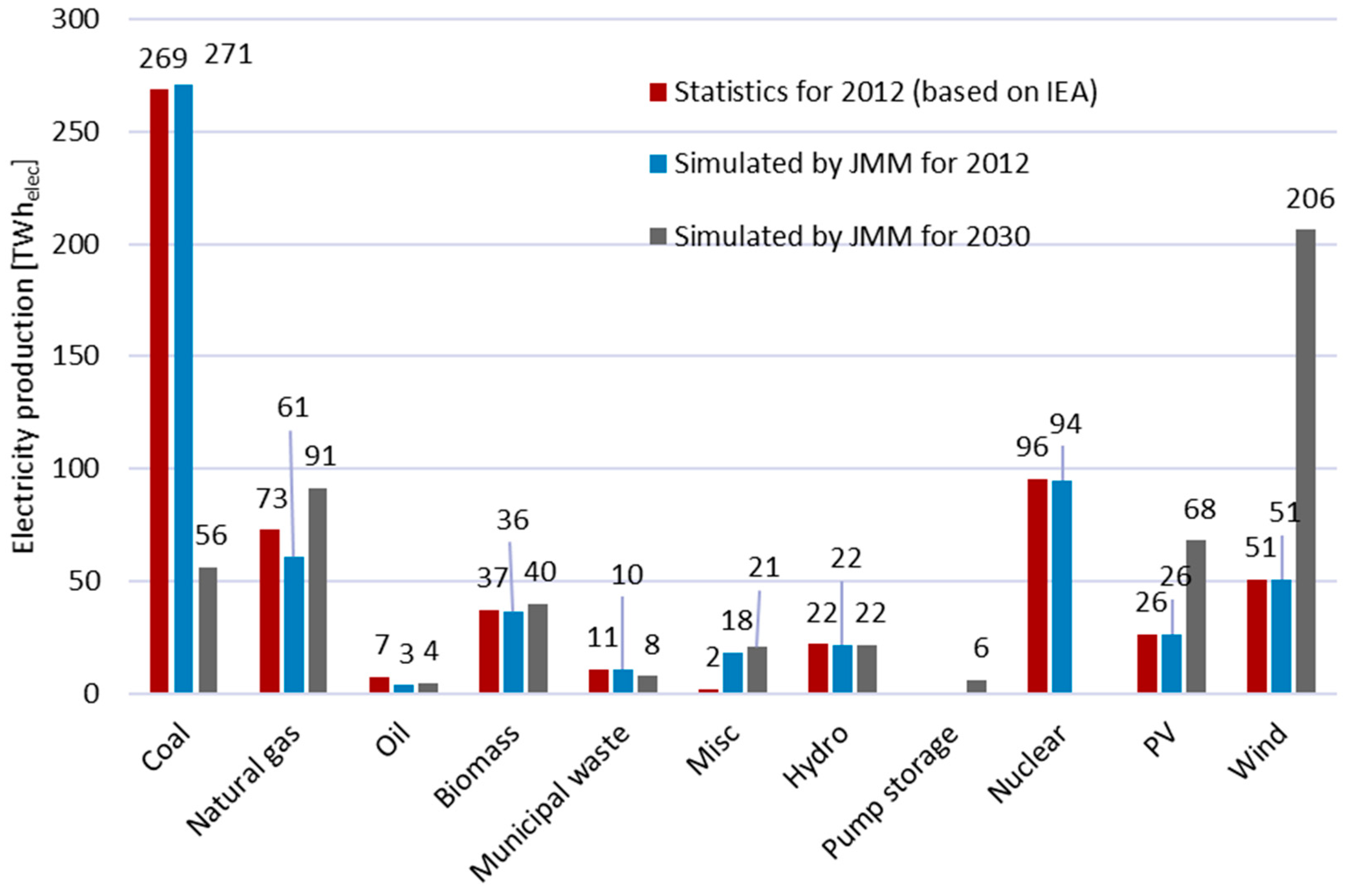

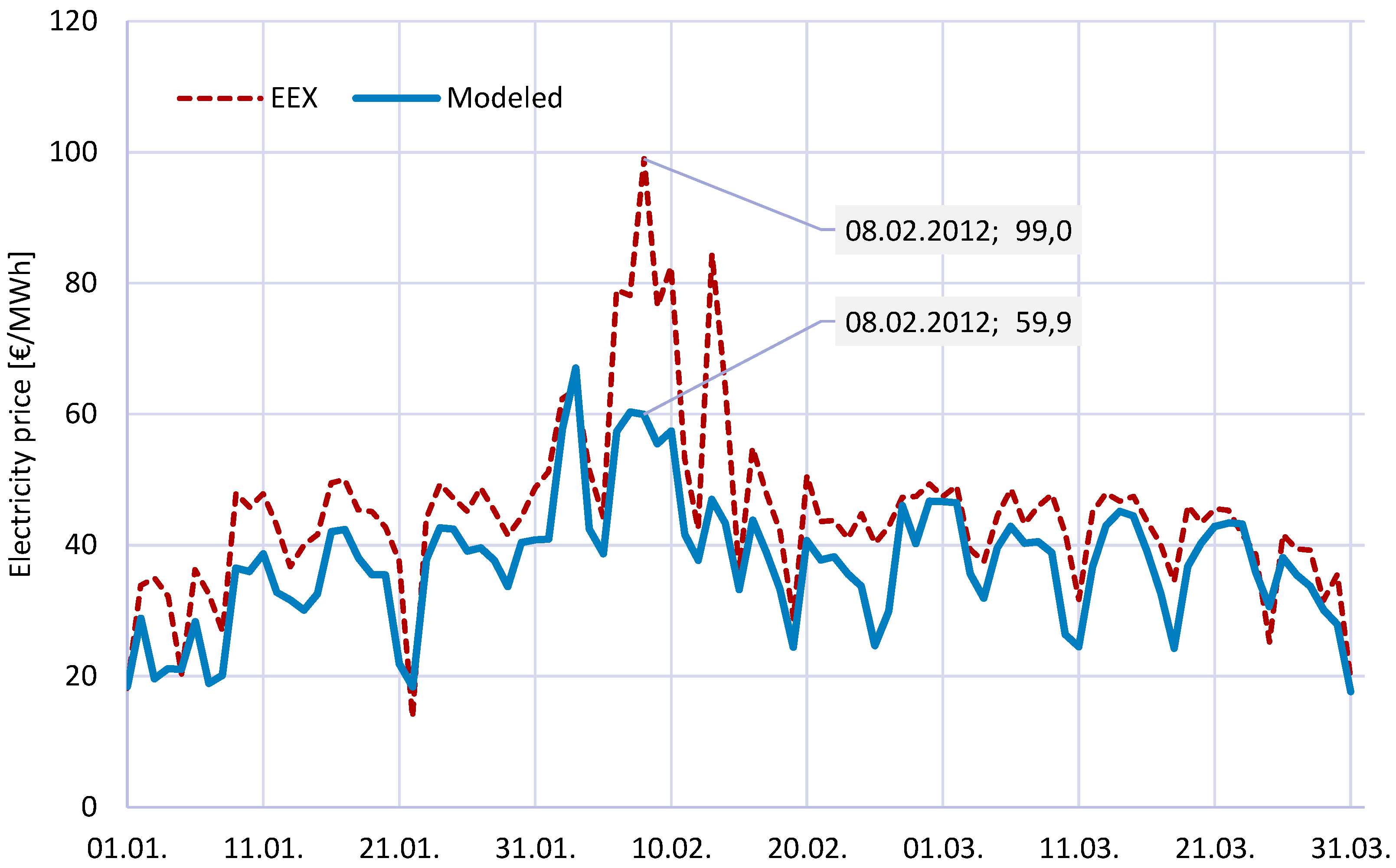
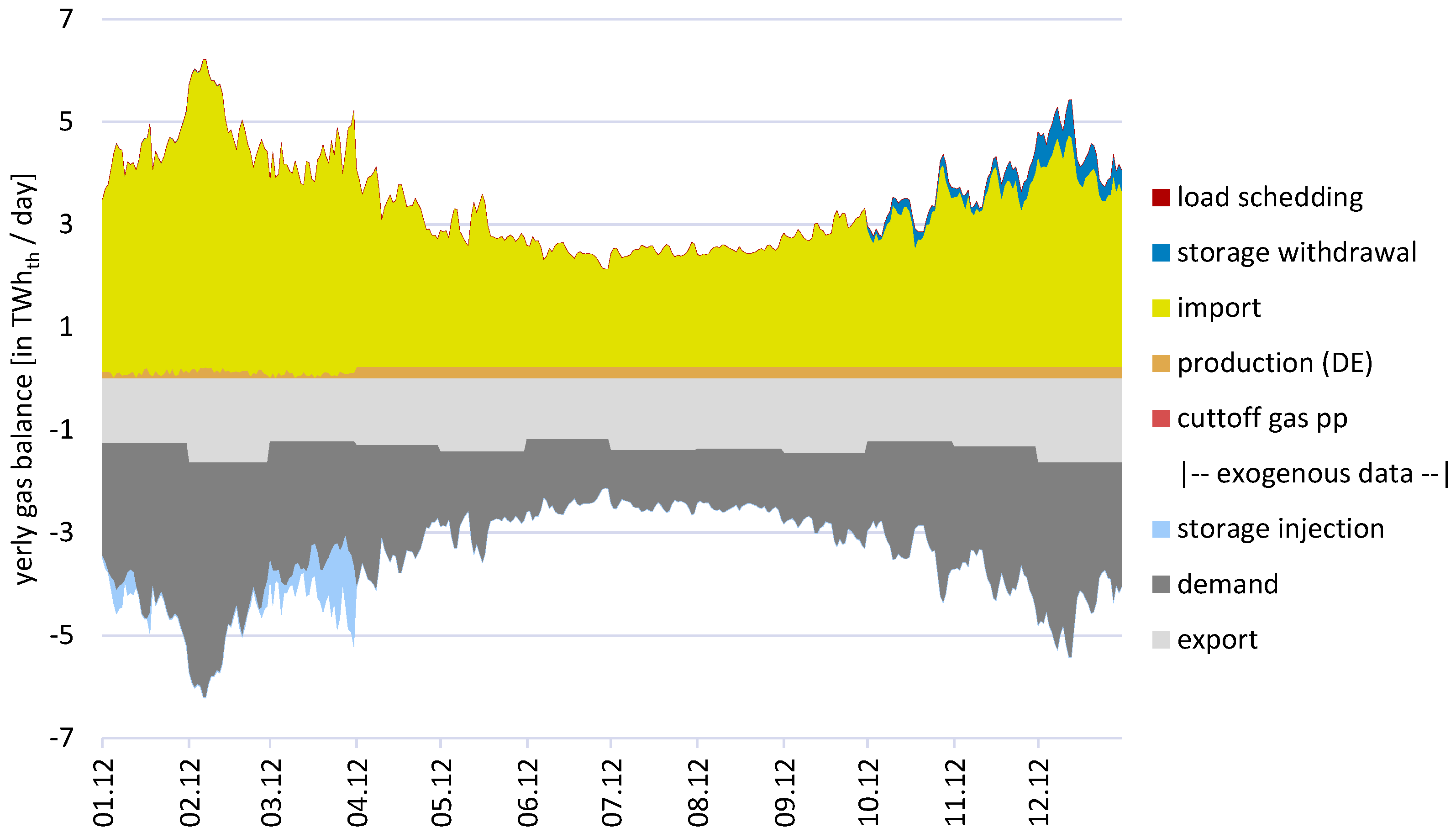
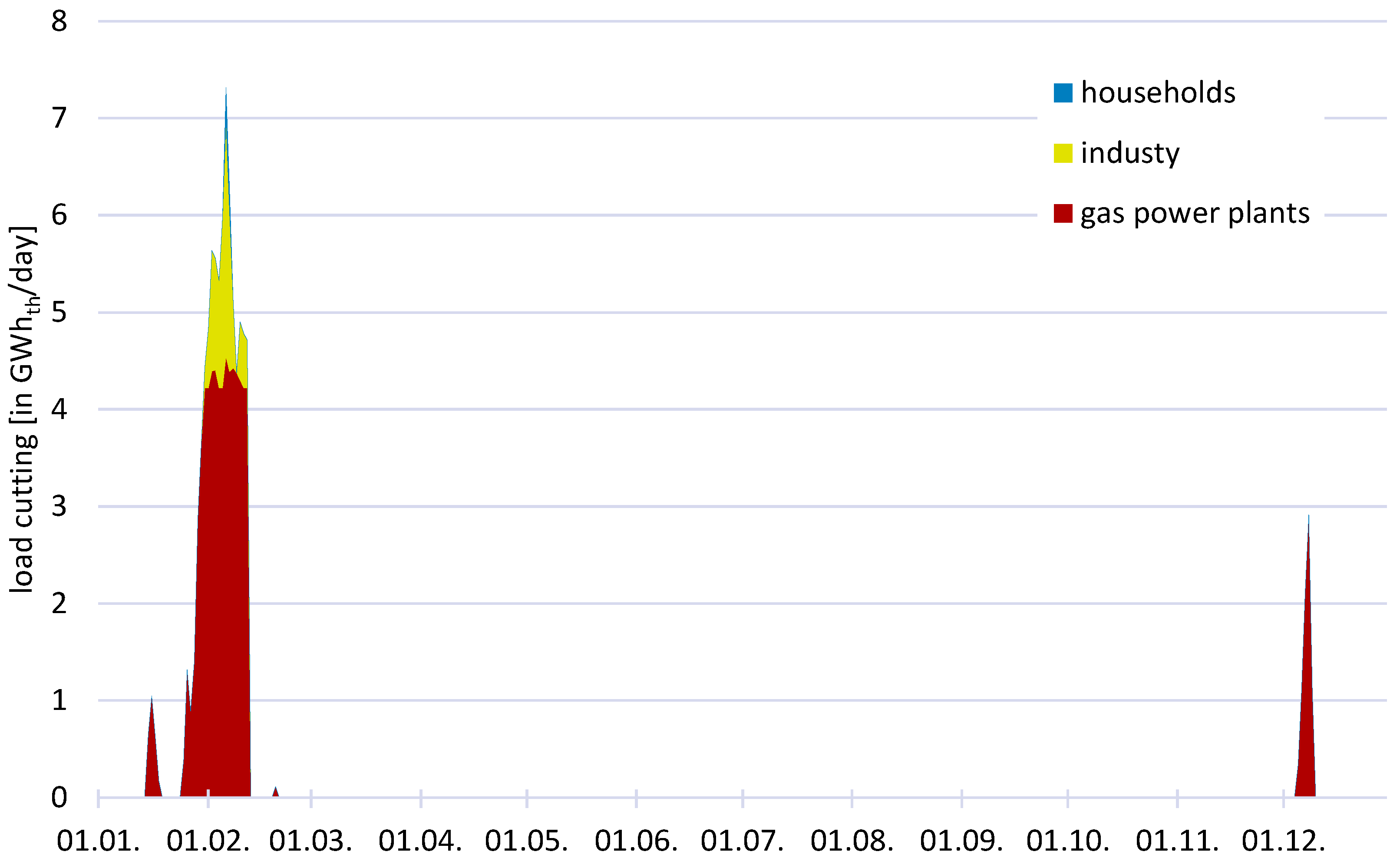
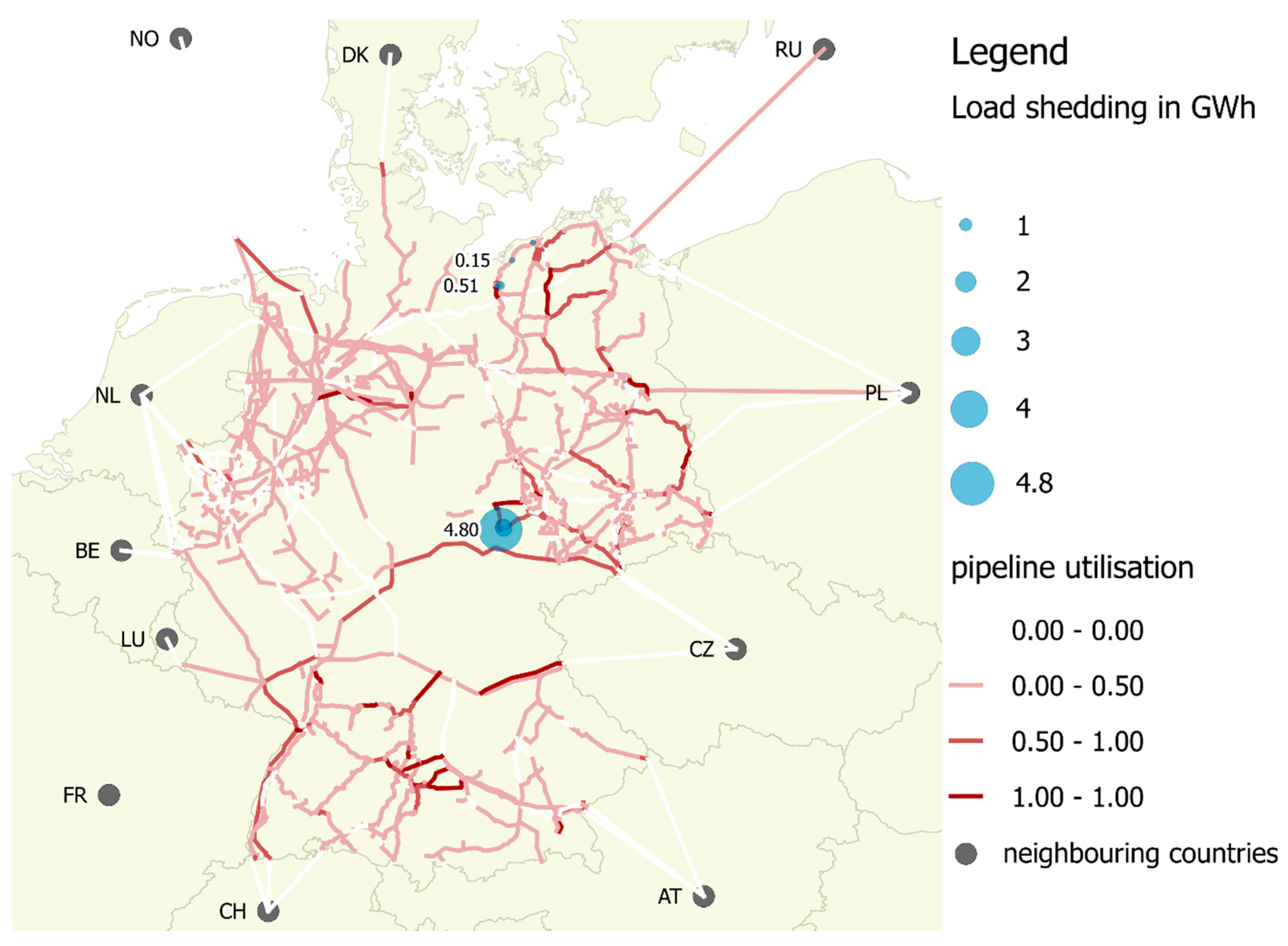
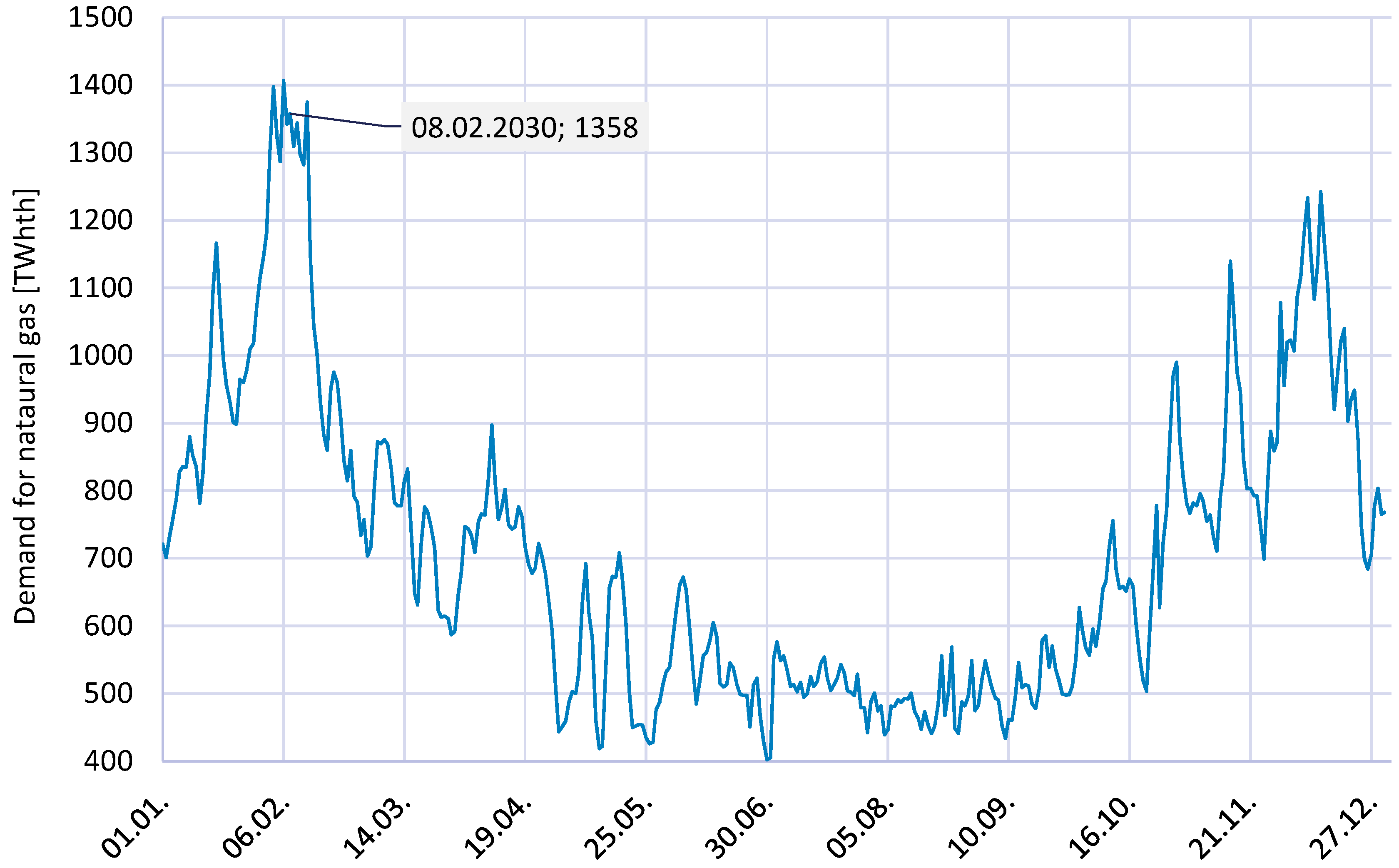
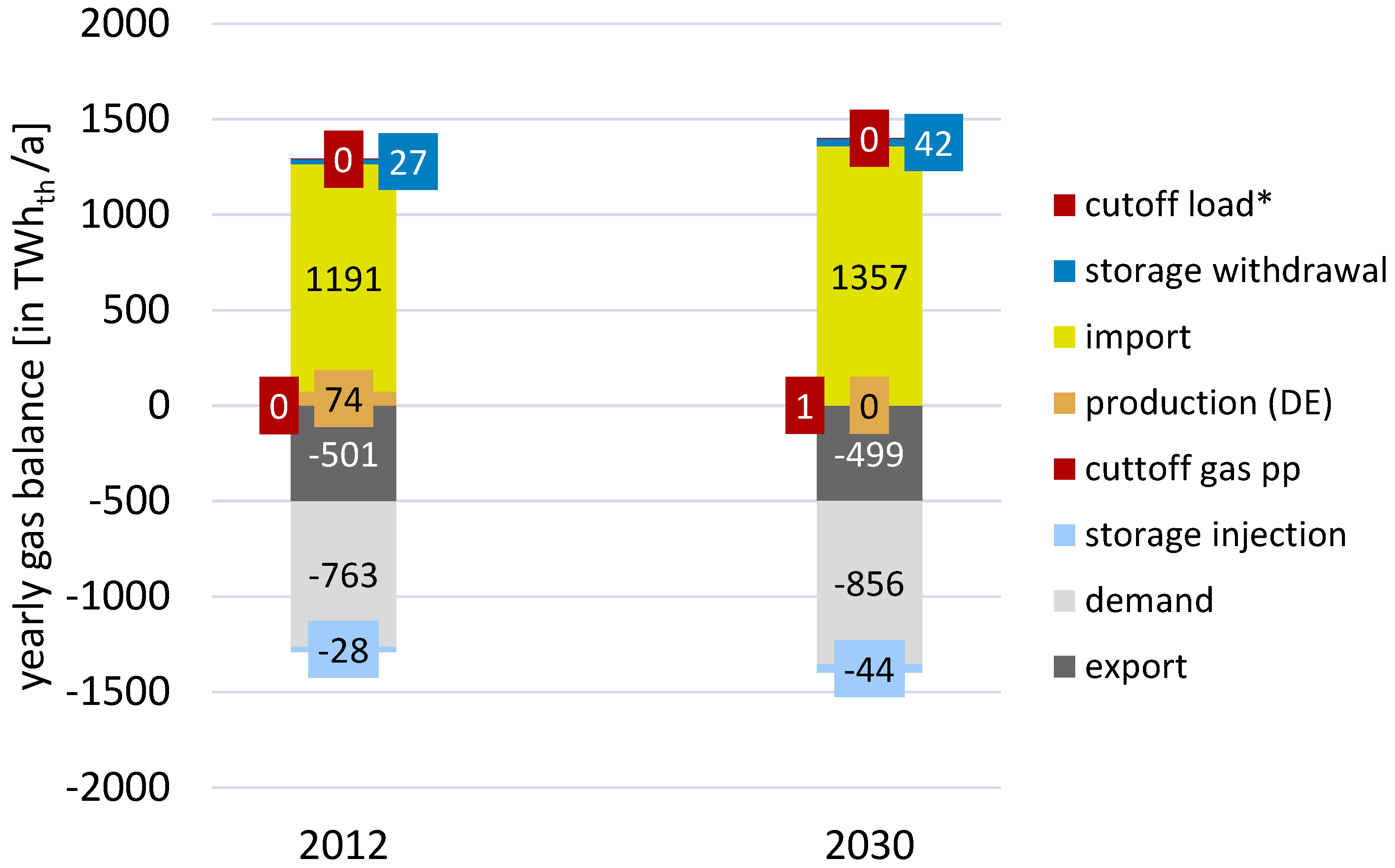
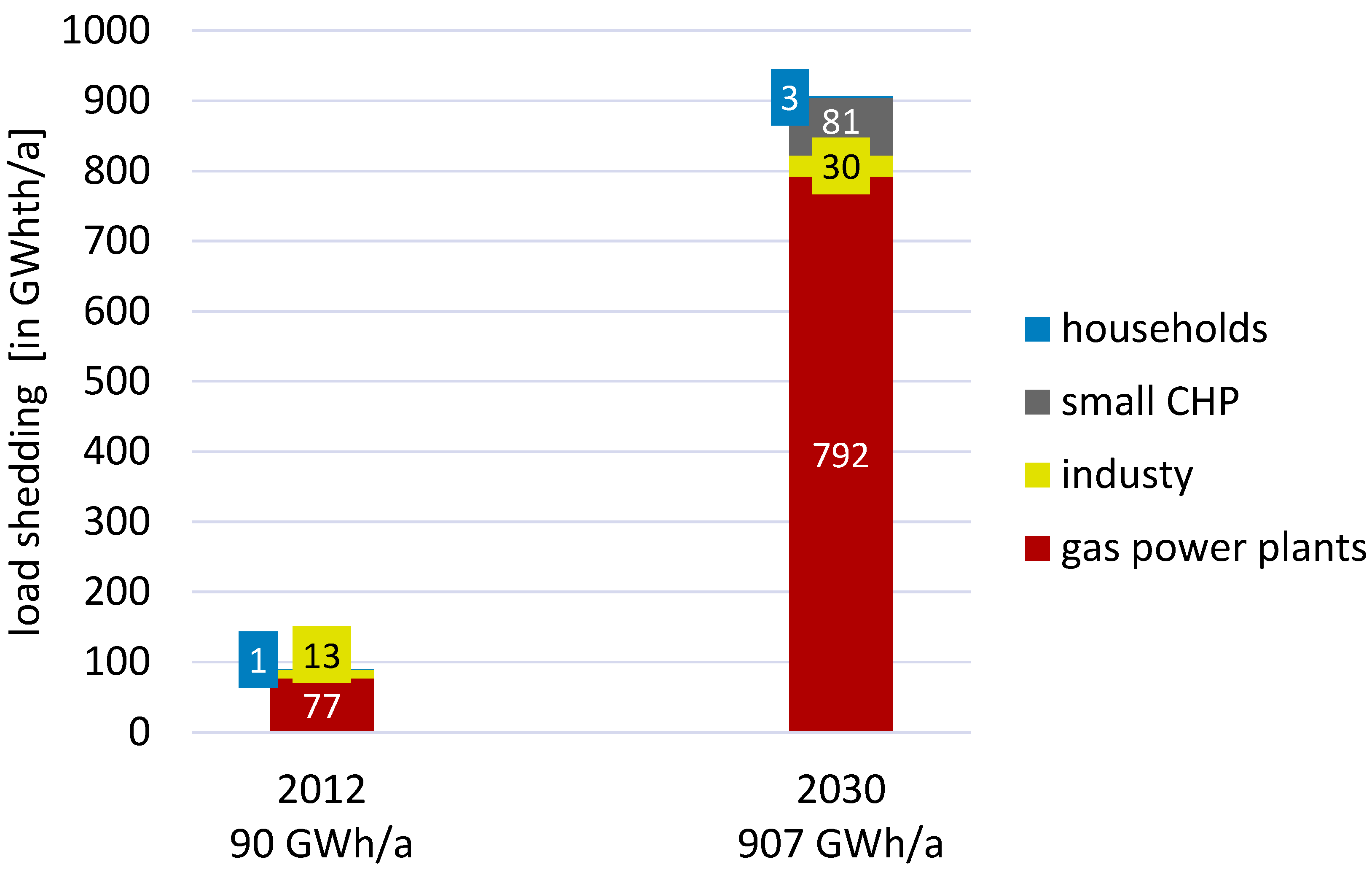
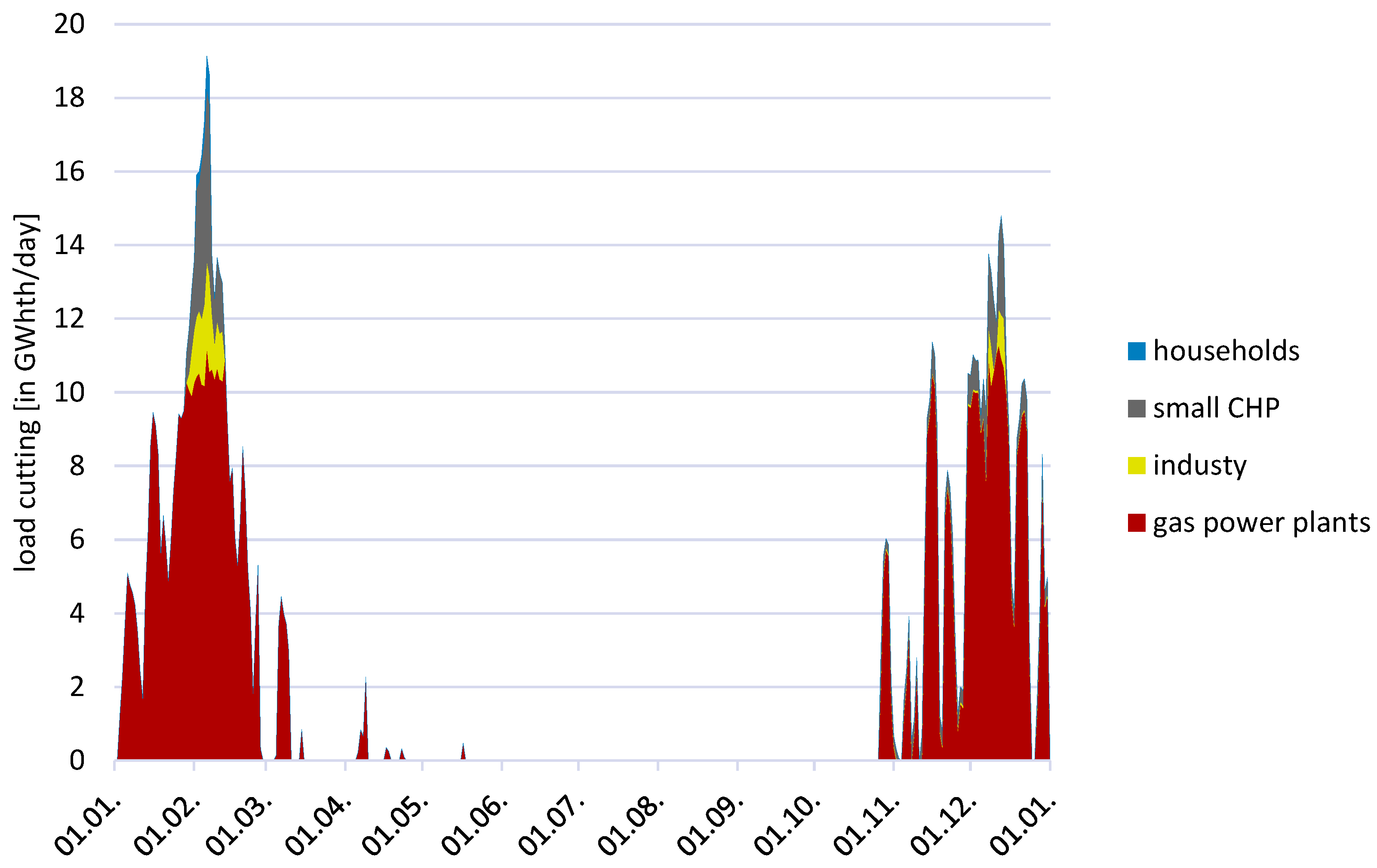
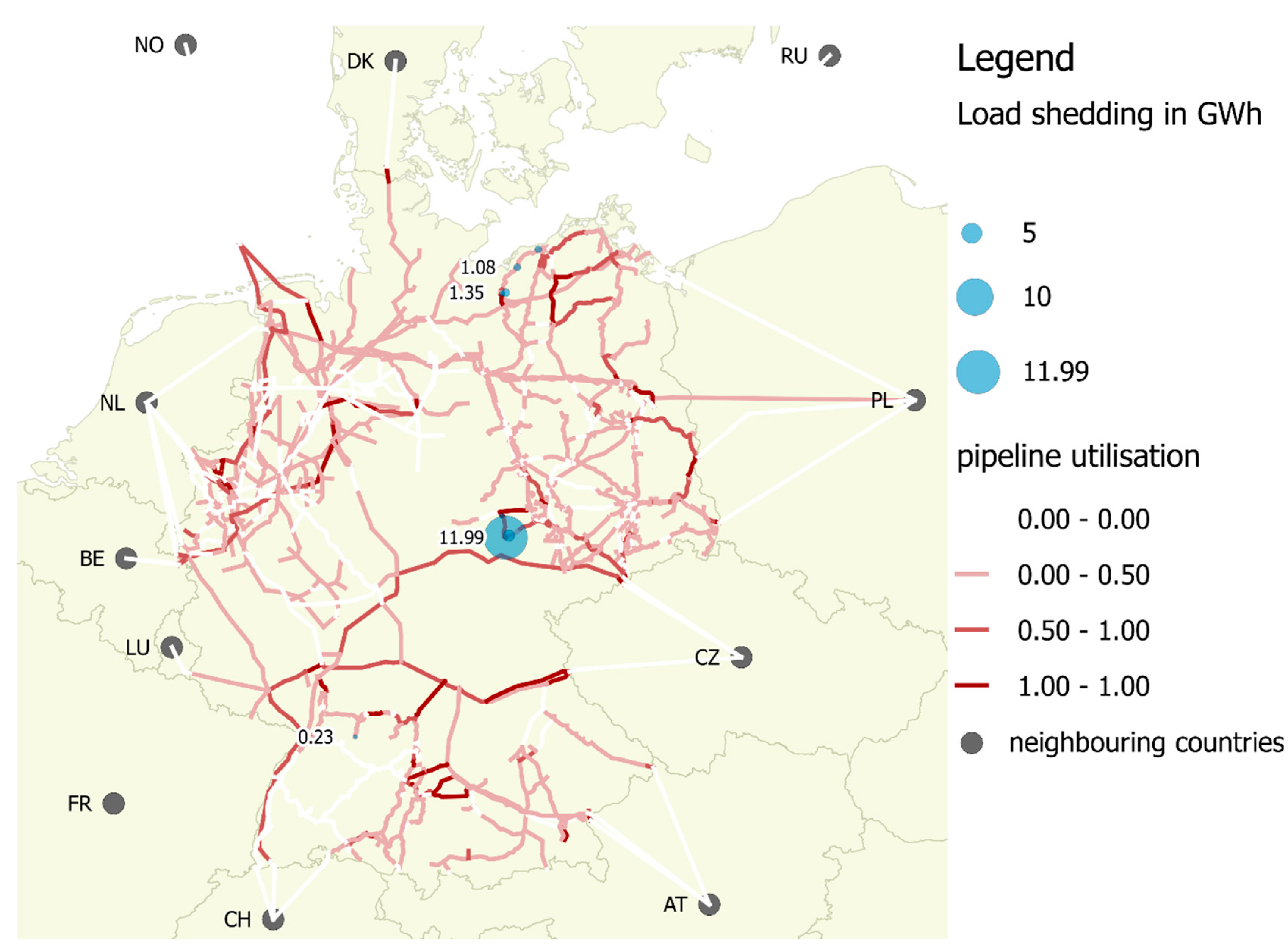
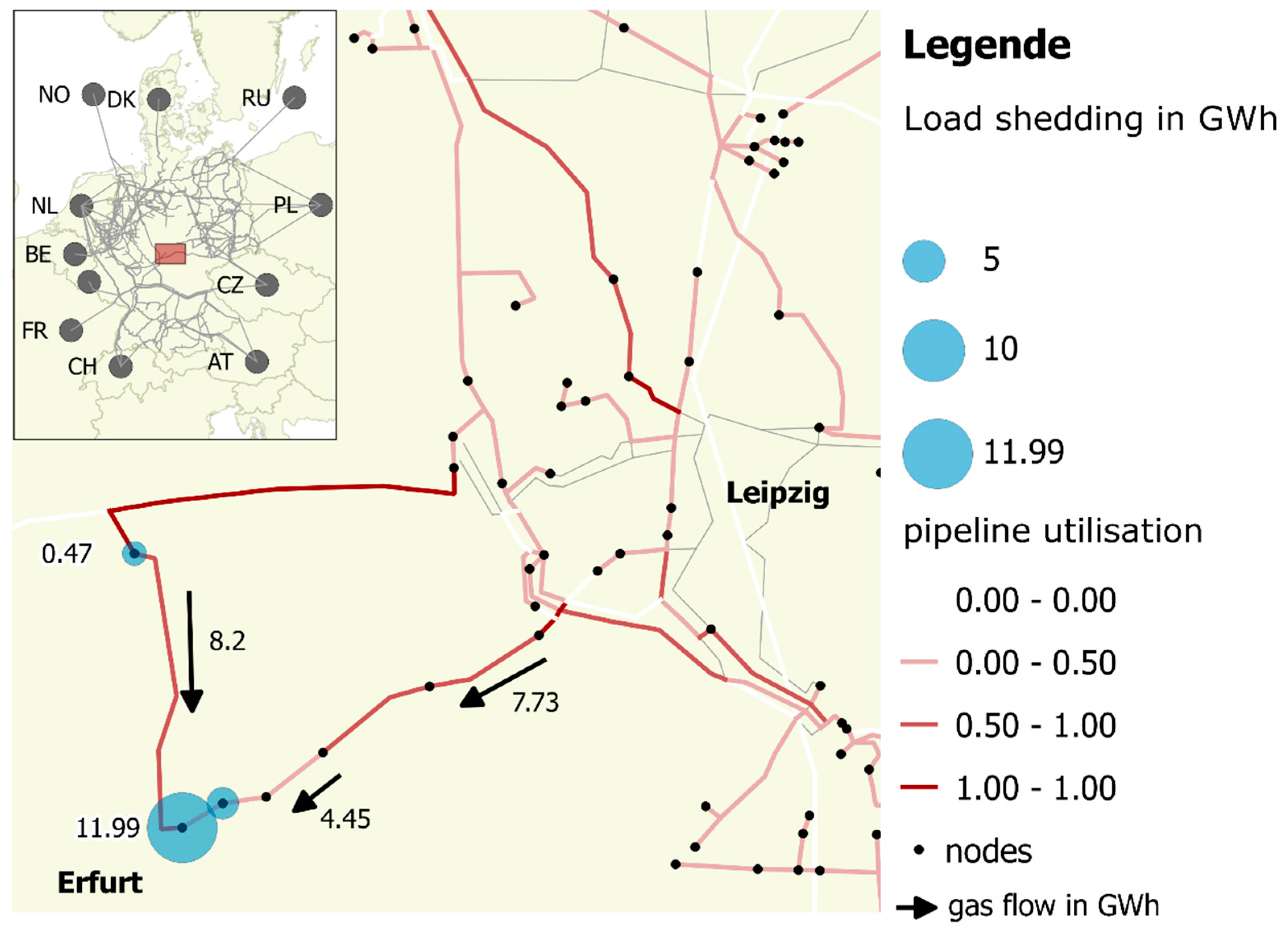
| Category of Assumption | Parameter | Back-Testing 2012 | Future Scenario: Gas as a Bridge Fuel in 2030 |
|---|---|---|---|
| General assumption for both models | Temperature time series | 2012 | 2012 |
| JMM | German electricity imports and exports | Historical data (ENTSO-E) | Simulated |
| Power plant capacities, Power transmission capacities | Historical data | EU: ENTSO-E TYNDP DE: NEP 2030 C | |
| Fuel & emission allowance prices | Historical data | NEP 2030 C | |
| Heat demand | Historical data | Historical data 2012 | |
| Time series of demand, renewable feed-in etc. | Historical data | Historical data 2012 | |
| GAMAMOD-DE | German gas exports | IEA 2012 | IEA 2012 |
| German gas imports | No Dutch gas imports | ||
| Gas import price | NCG natural gas quarter futures, 2012 | Scaled NCG natural gas quarter futures | |
| Infrastructure | Nord Stream I (23 bcm/a) | Nord Stream I + II (110 bcm/a) | |
| German gas production | No German gas production |
© 2019 by the authors. Licensee MDPI, Basel, Switzerland. This article is an open access article distributed under the terms and conditions of the Creative Commons Attribution (CC BY) license (http://creativecommons.org/licenses/by/4.0/).
Share and Cite
Hauser, P.; Heidari, S.; Weber, C.; Möst, D. Does Increasing Natural Gas Demand in the Power Sector Pose a Threat of Congestion to the German Gas Grid? A Model-Coupling Approach. Energies 2019, 12, 2159. https://doi.org/10.3390/en12112159
Hauser P, Heidari S, Weber C, Möst D. Does Increasing Natural Gas Demand in the Power Sector Pose a Threat of Congestion to the German Gas Grid? A Model-Coupling Approach. Energies. 2019; 12(11):2159. https://doi.org/10.3390/en12112159
Chicago/Turabian StyleHauser, Philipp, Sina Heidari, Christoph Weber, and Dominik Möst. 2019. "Does Increasing Natural Gas Demand in the Power Sector Pose a Threat of Congestion to the German Gas Grid? A Model-Coupling Approach" Energies 12, no. 11: 2159. https://doi.org/10.3390/en12112159
APA StyleHauser, P., Heidari, S., Weber, C., & Möst, D. (2019). Does Increasing Natural Gas Demand in the Power Sector Pose a Threat of Congestion to the German Gas Grid? A Model-Coupling Approach. Energies, 12(11), 2159. https://doi.org/10.3390/en12112159






